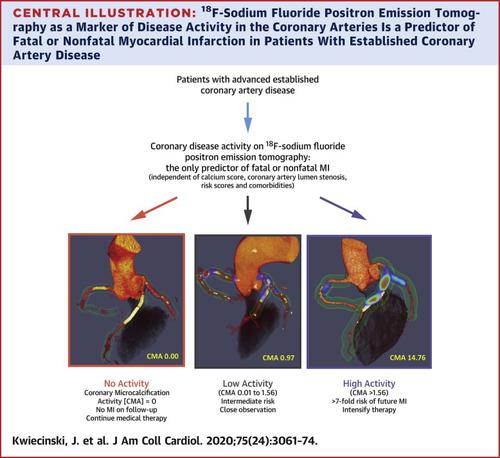当前位置:
X-MOL 学术
›
J. Am. Coll. Cardiol.
›
论文详情
Our official English website, www.x-mol.net, welcomes your feedback! (Note: you will need to create a separate account there.)
Coronary 18F-Sodium Fluoride Uptake Predicts Outcomes in Patients With Coronary Artery Disease
Journal of the American College of Cardiology ( IF 24.0 ) Pub Date : 2020-06-01 , DOI: 10.1016/j.jacc.2020.04.046 Jacek Kwiecinski 1 , Evangelos Tzolos 2 , Philip D Adamson 3 , Sebastien Cadet 4 , Alastair J Moss 3 , Nikhil Joshi 3 , Michelle C Williams 3 , Edwin J R van Beek 5 , Damini Dey 4 , Daniel S Berman 4 , David E Newby 3 , Piotr J Slomka 4 , Marc R Dweck 3
Journal of the American College of Cardiology ( IF 24.0 ) Pub Date : 2020-06-01 , DOI: 10.1016/j.jacc.2020.04.046 Jacek Kwiecinski 1 , Evangelos Tzolos 2 , Philip D Adamson 3 , Sebastien Cadet 4 , Alastair J Moss 3 , Nikhil Joshi 3 , Michelle C Williams 3 , Edwin J R van Beek 5 , Damini Dey 4 , Daniel S Berman 4 , David E Newby 3 , Piotr J Slomka 4 , Marc R Dweck 3
Affiliation

|
BACKGROUND
Reliable methods for predicting myocardial infarction in patients with established coronary artery disease are lacking. Coronary 18F-sodium fluoride (18F-NaF) positron emission tomography (PET) provides an assessment of atherosclerosis activity. OBJECTIVES
This study assessed whether 18F-NaF PET predicts myocardial infarction and provides additional prognostic information to current methods of risk stratification. METHODS
Patients with known coronary artery disease underwent 18F-NaF PET computed tomography and were followed up for fatal or nonfatal myocardial infarction over 42 months (interquartile range: 31 to 49 months). Total coronary 18F-NaF uptake was determined by the coronary microcalcification activity (CMA). RESULTS
In a post hoc analysis of data collected for prospective observational studies, the authors studied 293 study participants (age: 65 ± 9 years; 84% men), of whom 203 (69%) showed increased coronary 18F-NaF activity (CMA >0). Fatal or nonfatal myocardial infarction occurred only in patients with increased coronary 18F-NaF activity (20 of 203 with a CMA >0 vs. 0 of 90 with a CMA of 0; p < 0.001). On receiver operator curve analysis, fatal or nonfatal myocardial infarction prediction was highest for 18F-NaF CMA, outperforming coronary calcium scoring, modified Duke coronary artery disease index and Reduction of Atherothrombosis for Continued Health (REACH) and Secondary Manifestations of Arterial Disease (SMART) risk scores (area under the curve: 0.76 vs. 0.54, 0.62, 0.52, and 0.54, respectively; p < 0.001 for all). Patients with CMA >1.56 had a >7-fold increase in fatal or nonfatal myocardial infarction (hazard ratio: 7.1; 95% confidence interval: 2.2 to 25.1; p = 0.003) independent of age, sex, risk factors, segment involvement and coronary calcium scores, presence of coronary stents, coronary stenosis, REACH and SMART scores, the Duke coronary artery disease index, and recent myocardial infarction. CONCLUSIONS
In patients with established coronary artery disease, 18F-NaF PET provides powerful independent prediction of fatal or nonfatal myocardial infarction.
中文翻译:

冠状动脉 18F-氟化钠摄取可预测冠状动脉疾病患者的预后
背景缺乏可靠的方法来预测已确诊的冠状动脉疾病患者的心肌梗塞。冠状动脉 18F-氟化钠 (18F-NaF) 正电子发射断层扫描 (PET) 可评估动脉粥样硬化活动。目的 本研究评估 18F-NaF PET 是否可以预测心肌梗死,并为当前的风险分层方法提供额外的预后信息。方法 已知冠状动脉疾病的患者接受了 18F-NaF PET 计算机断层扫描,并在 42 个月(四分位距:31 至 49 个月)内对致死性或非致死性心肌梗死进行了随访。总冠状动脉 18F-NaF 摄取由冠状动脉微钙化活性 (CMA) 确定。结果 在为前瞻性观察研究收集的数据的事后分析中,作者研究了 293 名研究参与者(年龄:65 ± 9 岁;84% 为男性),其中 203 名(69%)显示冠状动脉 18F-NaF 活性增加(CMA >0)。致死性或非致死性心肌梗死仅发生在冠状动脉 18F-NaF 活性增加的患者中(203 例中的 20 例 CMA > 0 对 90 例中的 0 例 CMA 为 0;p < 0.001)。在接受者操作曲线分析中,18F-NaF CMA 对致命或非致命心肌梗死的预测最高,优于冠状动脉钙化评分、改良的杜克冠状动脉疾病指数和减少动脉粥样硬化血栓形成持续健康 (REACH) 和动脉疾病继发表现 (SMART)风险评分(曲线下面积:分别为 0.76 与 0.54、0.62、0.52 和 0.54;所有 p < 0.001)。CMA >1.56 的患者有一个 > 致死性或非致死性心肌梗死增加 7 倍(风险比:7.1;95% 置信区间:2.2 至 25.1;p = 0.003)与年龄、性别、风险因素、节段受累和冠状动脉钙化评分、冠状动脉支架的存在无关,冠状动脉狭窄、REACH 和 SMART 评分、杜克冠状动脉疾病指数和近期心肌梗死。结论 在确诊冠状动脉疾病的患者中,18F-NaF PET 对致命性或非致命性心肌梗死提供了强有力的独立预测。
更新日期:2020-06-01
中文翻译:

冠状动脉 18F-氟化钠摄取可预测冠状动脉疾病患者的预后
背景缺乏可靠的方法来预测已确诊的冠状动脉疾病患者的心肌梗塞。冠状动脉 18F-氟化钠 (18F-NaF) 正电子发射断层扫描 (PET) 可评估动脉粥样硬化活动。目的 本研究评估 18F-NaF PET 是否可以预测心肌梗死,并为当前的风险分层方法提供额外的预后信息。方法 已知冠状动脉疾病的患者接受了 18F-NaF PET 计算机断层扫描,并在 42 个月(四分位距:31 至 49 个月)内对致死性或非致死性心肌梗死进行了随访。总冠状动脉 18F-NaF 摄取由冠状动脉微钙化活性 (CMA) 确定。结果 在为前瞻性观察研究收集的数据的事后分析中,作者研究了 293 名研究参与者(年龄:65 ± 9 岁;84% 为男性),其中 203 名(69%)显示冠状动脉 18F-NaF 活性增加(CMA >0)。致死性或非致死性心肌梗死仅发生在冠状动脉 18F-NaF 活性增加的患者中(203 例中的 20 例 CMA > 0 对 90 例中的 0 例 CMA 为 0;p < 0.001)。在接受者操作曲线分析中,18F-NaF CMA 对致命或非致命心肌梗死的预测最高,优于冠状动脉钙化评分、改良的杜克冠状动脉疾病指数和减少动脉粥样硬化血栓形成持续健康 (REACH) 和动脉疾病继发表现 (SMART)风险评分(曲线下面积:分别为 0.76 与 0.54、0.62、0.52 和 0.54;所有 p < 0.001)。CMA >1.56 的患者有一个 > 致死性或非致死性心肌梗死增加 7 倍(风险比:7.1;95% 置信区间:2.2 至 25.1;p = 0.003)与年龄、性别、风险因素、节段受累和冠状动脉钙化评分、冠状动脉支架的存在无关,冠状动脉狭窄、REACH 和 SMART 评分、杜克冠状动脉疾病指数和近期心肌梗死。结论 在确诊冠状动脉疾病的患者中,18F-NaF PET 对致命性或非致命性心肌梗死提供了强有力的独立预测。


























 京公网安备 11010802027423号
京公网安备 11010802027423号